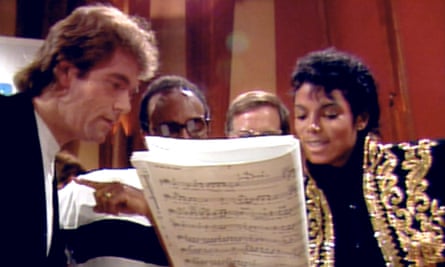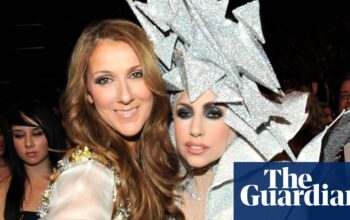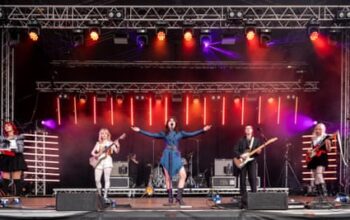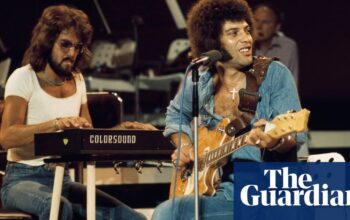Bao Nguyen’s The Greatest Night in Pop is a prime example of expert event planning, complete with hidden gems and 80s nostalgia.
Trying to fit a group of A-list celebrities or even a group of unenthusiastic friends and family members into one room at the same time can be a difficult task. Bringing together 46 popular musicians for a unpaid event would be almost impossible (which explains why most collaborations nowadays involve only two artists). Nguyen, who debuted his film about the creation of We Are the World at Sundance, spoke about the challenges of coordinating with numerous managers, publicists, and agents.
The Greatest Night in Pop serves as a last-minute miracle, organized by Hollywood manager Ken Kragen. Despite doubts about its success, Kragen and his team utilized their extensive contacts and other tactics to make it happen. They were able to secure big names like Lionel Ritchie and Michael Jackson as songwriters, following the rule of making sure that influential individuals were already involved.
Another superstar, the legendary singer Harry Belafonte, was the source of the fundraiser’s purpose: to staunch the problem of African famine. And Bob Geldof of the British charity Band Aid came on to share his wisdom regarding musical activism.
The event planners had a short amount of time to organize everything, but as soon as the introduction of Nguyen’s film was over, we were already introduced to famous musicians such as Bruce Springsteen, Cyndi Lauper, Bette Midler, Paul Simon, and Diana Ross. Encouraged by producer Quincy Jones and fueled by a late-night meal of chicken and waffles, the group gathered their energy and sang a memorable song that stayed in our minds until the morning.
The song’s enduring popularity is due in part to its ingeniously straightforward structure. According to Nguyen, “The chorus is designed to accommodate a wide range of vocal abilities.” Lionel and Michael crafted it as an anthem that can be easily sung along to.
The melody holds a special place in the director’s childhood recollections. While living in Maryland with his Vietnamese refugee parents, the tune was frequently played. During a recent trip to visit his parents in Vietnam, where they now reside, the song played on the taxi radio. “I felt compelled to make this film,” he expressed.
The idea for the project emerged as a solution to the challenges posed by the Covid pandemic. In early 2020, the director and producer Julia Nottingham, who had just released their documentary Be Water about Bruce Lee, decided that their next project would also need to utilize existing footage. Nottingham had a connection to the company behind the American Music Awards, a precursor event for artists heading to the recording studio. She contacted music producer Larry Klein, who happened to possess a large amount of unseen video footage. According to Nguyen, Klein’s response was, “I’ve been waiting 35 years for this phone call.”
The director, who is 40 years old, initially had doubts about being the right person to tell the story. One reason was because he didn’t remember when the song came out. Additionally, he had never made a music documentary before. However, after thinking it over, the answer became clear. He found the story to be incredibly compelling and saw it as his role as a filmmaker to uncover something new, meaningful, and personal. As he delved into the materials, his vision for the project formed. He saw it as a heist film, with a similar feel to Ocean’s 11, involving a covert mission to bring together 40 of the most famous individuals in the world for an all-night event at a secretive location.
The movie is filled with a strong sense of suspense. When the actors arrived at the studio, they were reminded by Jones to leave their egos behind. The genuine interactions captured in the footage, like the stars asking for autographs, also captivated Nguyen. It was incredible to see these superstars being so down-to-earth.

Display the image in full screen mode.
Around midnight, the artists started to lose energy. Dylan required assistance with his timing. Stevie Wonder proposed that the group sing in Swahili – causing a discussion about whether the people of Ethiopia, who were heavily impacted by famine, speak Amharic or Swahili. This scenario may sound familiar to anyone who has been in a chaotic group Zoom meeting.
However, they persisted and relaxed, becoming excited and silly, similar to a group of children at a sleepover. Despite the abundance of different personalities in the small space, there was surprisingly little conflict. This may be because the real drama took place off camera: Madonna was not invited (the producers chose Lauper instead of the Material Girl) and Prince had requested to record a solo in a separate room, a request that was denied.
The song generated over $60 million, but Nguyen highlights that its influence was much larger by bringing attention to the issue of African famine on a global scale. “Currently, we are constantly bombarded with images of poverty, but I believe it truly motivated a significant amount of foreign aid,” and helped pave the way for many artist-activists.
Amazingly, Nguyen has not grown tired of the song. He expressed his concern about this in making the documentary, but ultimately, he still enjoys it. He even listened to it this morning while getting ready.
This article was updated on January 30, 2024. A previous version incorrectly identified Ken Kragen as “Kraven”.
-
“The Biggest Pop Night” is now streaming on Netflix.
Source: theguardian.com


